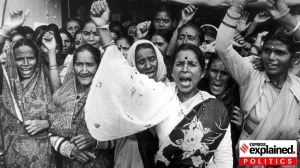God’s own tourism
As the domestic tourist season opens up for summer, it is the conspicuous success of Kerala’s tourism enterprise that becomes top of th...

As the domestic tourist season opens up for summer, it is the conspicuous success of Kerala’s tourism enterprise that becomes top of the mind. As far as tourism is concerned, Kerala really is God’s own country: beaches, backwaters, hill stations, wildlife sanctuaries, Ayurveda, festival.
All of this is set against a backdrop of a state with an unpolluted environment, a very high quality of life, an excellent healthcare system and almost total literacy. It is this amazing combination of strengths that makes Kerala unique.
But if Kerala is internationally renowned as a tourist destination today, it is also because of an excellent, highly focussed, multi-pronged brand-building strategy. Today, tourism brings in over Rs 4,000 crore into the state’s kitty and generates over seven lakh jobs, besides attracting investments that have touched over Rs 1000 crore a year.
According to recent research conducted by the World Travel and Tourism Council (WTTC), Kerala’s travel and tourism demand is expected to grow by 11.6 per cent per annum over the coming decade. This is the highest recorded growth rate in the world eclipsing Turkey, at 10.2 per cent. Even more remarkable, Kerala is expected to register a record growth of 23.5 per cent in terms of visitor exports over the next ten years. India’s estimates for this period are 14.3 per cent, while the world average is only 6.5 per cent. Over the next ten years, WTTC forecasts suggest Kerala will nearly triple its current level of travel and tourism economy employment from 6,93,000 to 2.0 million in 2012. This has enormous significance since the creation of job opportunities is the state’s single highest priority.
What paid Kerala Tourism great dividends was its focus on quality, rather than mass tourism. This was a lesson the state learnt the hard way. Kovalam’s cluttered development in the seventies and eighties came as a warning signal of the dangers of developing mass tourism without focus. Today the emphasis, clearly, is on quality in terms of accommodation as well as facilities — especially in new hotspots like Kumarakom and Munnar. Kerala Tourism has understood early enough that the key to sustaining the business of tourism lies in sustaining the destination in all its natural beauty. Its emphasis, therefore, has been in ensuring that the tourist gives more to the destination than what he takes from it.
In a special collector’s issue released just before the turn of the century, the National Geographic Traveler gifted the tourists of the world with a well-researched compilation of the 50 places of a lifetime. The only Indian destination that featured was Kerala.
The state was celebrated as a ‘Paradise Found’, one of the ten in the world. But it’s not just foreign travellers who are being wooed, people like Sir Paul McCartney. Thanks to innovative marketing using brand ambassadors like M.F. Husain, Kerala has captured the imagination of the affluent Indian traveller as well, not least of all the Prime Minister!
Incidentally, Kerala is also the first Indian state to use information technology to promote tourism. The website ‘‘www.keralatourism.org’’ is considered one of the best and largest in the country. Updated every week, the site features an interesting profile of the state’s culture, fairs, festivals, tourist attractions and enables the consumer to experience the destination through a virtual reality tour.
Yet another aspect, Kerala’s success highlighted is the fact that much can be achieved through a synergic private-public partnership. This close and fruitful relationship is visible in every activity in the state, right from policy formulation to quality control and marketing. The state government has redefined its own role in order to encourage entrepreneurship. Today it is a catalyst rather than a regulator and promotes a conducive atmosphere for tourism to flourish, by organising for instance events like the Kerala Travel Mart, in which almost 1,000 distinguished tour operators participated.
In addition to its smart marketing strategy, Kerala has also evolved an excellent gameplan to convert the traditionally lean monsoon months by promoting Ayurveda. The only state in India that practiced this ancient health science with dedication, Kerala positioned itself to assure tourists that the rainy season is the best time for rejuvenation.
And clearly the ancient texts validate the claim. During the monsoon, the pores of the body open to a maximum, making the skin most receptive to therapy. An added bonus is the magic of the monsoons which is best experienced here. Thus has come about a marketing turnaround that’s rejuvenated a traditionally lean tourist season, reinforcing Kerala’s claim to being a land where the season never ends.
How does the hospitality industry in Kerala differ from that in the rest of the world? Kerala Tourism is a product of unique classy boutique resorts. The sector is entrepreneur-led, not Five Star driven. Therefore it showcases personalised service and ethnic architecture which has been reinforced by traditional culture and cuisine. The private sector understands the need to sustain the destination. All properties, big and small, wear the eco-friendly banner and promote the ethnic experience. In fact, Kerala was one of the first states to realise the potential of eco-tourism as a concept.
Inherent strengths, smart strategies, foresight and synergic relationships have made Kerala what it is today — the multi-destination hotspot of the millennium. The onus is now on the industry to sustain the development as well as the destination. The task will surely be tougher. As a core-competency industry that contributes to the general social and economic development, the state has been campaigning to create awareness about tourism among local people. A sensible and sensitive participation from the people will play a key role in ensuring that the industry flourishes without damaging the land and the lives of its people.
— The writer is Joint Secretary, Ministry of Tourism
Photos



- 01
- 02
- 03
- 04
- 05




























